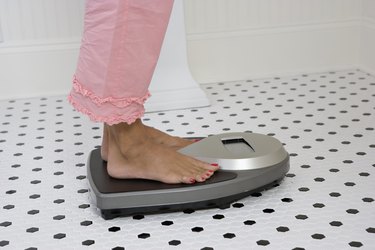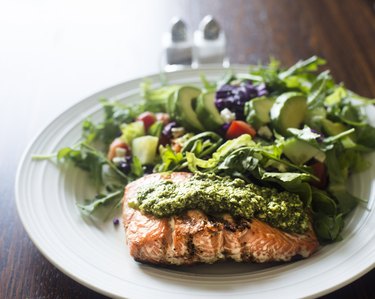
If you're looking for the best weight-loss program for you, perhaps you've stumbled across the Flat Belly Diet during your search. The program promises weight loss of up to 15 pounds in 32 days. But then there's the million-dollar question: Does the Flat Belly Diet work, and is it safe?
Here's our review of the diet, including how it works, what you can (and can't) eat and whether it'll really help with weight loss, all of which can help can decide if it's worth your time.
Video of the Day
Video of the Day
So, What Is the Flat Belly Diet?
The Flat Belly Diet was created by Prevention magazine, per the Mayo Clinic. It debuted in 2008 with the release of the book Flat Belly Diet! Since then, various extensions of the book have been published, including a Flat Belly Diet! Pocket Guide, numerous cookbooks, Flat Belly Diet! Diabetes, Flat Belly Diet! For Men and so on.
The diet promises that you will lose up to 15 pounds in just 32 days. The 32 days comes from the two phases of the diet, according to the Mayo Clinic, which include:
- The Flat Belly Diet 4-Day Jumpstart: This phase focuses on reducing bloating from water retention, gas and constipation by eating 1,600 calories a day — predominately fruits, vegetables, whole grains and a proprietary water recipe. It's recommended that you avoid high-sodium foods and beverages.
- The 4-Week Meal Plan: This phase involves following a calorie-restricted diet for a month — 1,600 calories a day for people assigned female at birth and 2,000 calories for people assigned male at birth, to be exact.
The premise of the diet is focused on one unique nutrient — monounsaturated fats (MUFAs) — because growing research at the time showed this fatty acid may play a role in reducing belly fat. As a result, MUFAs are included in every meal on the Flat Belly Diet plan.
Sources of this beneficial, unsaturated fat include:
- Nuts
- Seeds
- Fatty fish like salmon and sardines
Exercise is optional on the Flat Belly Diet, according to the Mayo Clinic.
Importantly, the diet is no longer maintained by its creators (in other words, the plan hasn't been updated in more than a decade). Nevertheless, the Flat Belly Diet! line of books and resources are still available for sale.
Warning
Losing weight at a pace of 1 to 2 pounds per week is safe and sustainable, per the Centers for Disease Control and Prevention. Anything faster than that — like the Flat Belly Diet's alleged 15-pound weight loss in about a month — can deprive you of necessary nutrients and burn muscle instead of fat, neither of which is safe for your body or supports weight maintenance in the long term, per the Cleveland Clinic.
Does It Work for Weight Loss?

The short answer is yes, but not necessarily for good.
The program is a four-day 1,600-calorie meal plan and month-long 1,600- to 2,000-calorie diet based on predominately whole foods, so if your daily calorie needs are above this amount, you will likely lose weight on this plan, according to the Mayo Clinic.
With that said, there's nothing inherently unique about this diet compared to most other calorie-restricted programs. While monounsaturated fats are beneficial, they are not a magical nutrient that will help you shed weight — especially the suggested 15 pounds in 32 days, which is a potentially dangerously fast rate of weight loss, per the Cleveland Clinic.
And any weight loss you do experience on the Flat Belly Diet may not last, according to the Mayo Clinic. That's because long-term, sustained weight loss requires permanent lifestyle changes like eating a nutritious diet and exercising regularly, as opposed to the month-long quick fix that this program offers.
What You Can (and Can’t) Eat on the Flat Belly Diet Plan
The diet is focused on eating MUFAs throughout the day, so foods rich in these fats make up a large portion of the diet. Here's a breakdown of foods that are allowed and foods to avoid on the Flat Belly Diet, according to the Mayo Clinic.
Foods to Eat
- Plant-based oils like olive and avocado oil
- Avocados
- Nuts and seeds
- Dark chocolate
- Soybeans
- Fruit and most vegetables
- Whole grains
- Lean meats and poultry
Foods to Limit or Avoid
- Highly processed foods like packaged baked goods
- Salty foods like fast food
- Potential gas-promoting foods like cabbage, broccoli, Brussels sprouts (especially during the four-day jumpstart)
- Citrus fruit
- Artificial sweeteners
Pros of the Flat Belly Diet
There are some possible advantages to the program, including:
1. It Emphasizes Whole Foods
The diet is loosely based on the heart-supporting Mediterranean diet, per the Mayo Clinic. This eating style is backed by decades of research, is ranked the No. 1 Best Diet Overall by U.S. News & World Report and focuses on eating whole, nutrient-dense foods with a particular emphasis on monounsaturated fats.
2. It's Low in Processed Foods
Also similar to the Mediterranean diet, the Flat Belly Diet is generally low in saturated fats and sodium, according to the Mayo Clinic. This further contributes to its heart health-supporting properties.
3. It Doesn't Require Special Products
The program doesn't require you to buy specific brand foods or supplements, which gives you more flexibility than some other diet programs, per the Mayo Clinic.
Cons of the Flat Belly Diet
On the other hand, there are some disadvantages to be aware of before you try this weight-loss program, including:
1. It's Strict
The program is pretty regimented and also reinforces the harmful idea that you should be thin. As a result, it can trigger disordered eating, according to the University of Michigan School of Public Health. So if you have a history of eating disorders, it's best to skip this diet.
2. It Doesn't Live Up to Its Promises
The promised results of losing up to 15 pounds in 32 days are likely overstated. Regardless, losing weight that quickly usually isn't safe, sustainable or doctor-recommended, per the Cleveland Clinic.
3. It Lacks Research
It's worth noting that there's not much research on this specific diet's effectiveness, according to the Mayo Clinic. Large, long-term studies are needed to better understand the program's effects and whether or not it's safe.
4. It May Not Be Safe if You Have an Underlying Condition
Following a calorie- or food-restrictive diet may not always be the best choice for people with underlying health conditions, according to the Mayo Clinic. That's because you may have specific nutritional needs that aren't addressed by the diet.
Tip
If you have a health condition, talk to your doctor or dietitian before trying this or any other diet program to make sure your nutritional needs will be met, per the Mayo Clinic.

Here's a sample day's menu on the Flat Belly Diet:
Breakfast
- Mediterranean Morning Scramble (202 calories)
- The Greco-Brecko Mediterranean Toast With Hummus and Olives (206 calories)
Lunch
Farro Mediterranean Bowl (357 calories)
Snack
- Energizing Green Smoothie (284 calories)
- 1 oz cashews (164 calories)
Dinner
- Lentil Pasta With Creamy Red Pepper Sauce and Spinach (273 calories)
- Endive Mediterranean Mix (235 calories)
Total calories: 1,721
Should You Try It?
While the Flat Belly Diet may result in short-term weight loss, dropping pounds at such a fast rate isn't typically safe. What's more, the weight you do lose may not stay off given the lack of focus on building long-term, safe and sustainable habits, per the Mayo Clinic.
As a result, you're likely better off taking a different approach to weight loss. Here are some alternative options:
1. Adopt the Mediterranean Diet
A smarter tactic for weight loss and overall health may be to try the Mediterranean diet, per the Mayo Clinic. It prioritizes beneficial foods without restricting your calories or confining your eating habits to a set period of time, all of which can benefit your health — no matter your weight — in the long term.
2. Limit Processed Foods
By filling up on nutritious, whole foods, you'll have less room for sugary or highly processed foods (think: chips, crackers, sweets), which can add to weight gain, per the Mayo Clinic.
- U.S. News & World Report: "Best Diets Overall"
- Mayo Clinic: "What's the Flat Belly Diet, and can it help you lose weight?"
- Centers for Disease Control and Prevention: "Losing Weight"
- Cleveland Clinic: "Is It Bad to Lose Weight Too Quickly?"
- Mayo Clinic: "Weight loss: Choosing a diet that's right for you"
- University of Michigan School of Public Health: "The Problem with Dieting: Eating Disorders Affecting American College Students"